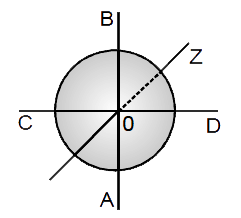The moment of inertia of thin spherical shell of mass M and radius R about a diameter is 23MR. Its radius of gyration K about a tangent will be
√23R
23R
53R
√53R
The correct Answer is:D
To find the radius of gyration K of a thin spherical shell about a tangent, we can use the parallel axis theorem. Let's go through the solution step by step:
Step 1: Understand the moment of inertia about the diameter
The moment of inertia I of a thin spherical shell of mass M and radius R about a diameter is given by:
ICM=23MR2
Step 2: Apply the parallel axis theorem
The parallel axis theorem states that the moment of inertia about any axis parallel to an axis through the center of mass is given by:
I=ICM+Md2
where d is the distance between the two axes.
Step 3: Determine the distance d
In our case, the distance d from the center of the sphere to the tangent is equal to the radius R of the sphere.
Step 4: Substitute values into the parallel axis theorem
Now, substituting the values into the equation:
Itangent=ICM+MR2
Itangent=23MR2+MR2
Step 5: Simplify the equation
Combine the terms:
Itangent=23MR2+33MR2=53MR2
Step 6: Relate moment of inertia to radius of gyration
The moment of inertia can also be expressed in terms of the radius of gyration K:
I=MK2
Setting the two expressions for I equal gives:
MK2=53MR2
Step 7: Solve for K2
Dividing both sides by M (assuming M≠0):
K2=53R2
Step 8: Take the square root to find K
Taking the square root of both sides:
K=√53R
Final Answer
Thus, the radius of gyration K about a tangent is:
K=R√53
---
The moment of inertia I of a thin spherical shell of mass M and radius R about a diameter is given by:
ICM=23MR2
The parallel axis theorem states that the moment of inertia about any axis parallel to an axis through the center of mass is given by:
I=ICM+Md2
where d is the distance between the two axes.
In our case, the distance d from the center of the sphere to the tangent is equal to the radius R of the sphere.
Now, substituting the values into the equation:
Itangent=ICM+MR2
Itangent=23MR2+MR2
Combine the terms:
Itangent=23MR2+33MR2=53MR2
The moment of inertia can also be expressed in terms of the radius of gyration K:
I=MK2
Setting the two expressions for I equal gives:
MK2=53MR2
Dividing both sides by M (assuming M≠0):
K2=53R2
Taking the square root of both sides:
K=√53R
Thus, the radius of gyration K about a tangent is:
K=R√53
Topper's Solved these Questions
Similar Questions
Knowledge Check
The moment of inertia of a thin circular disc of mass M and radius R about any diameter is
AMR24BMR22CMR2D2MR2The moment of inertia of a thin circular disc of mass M and radius R about any diameter is
AMR24BMR22CMR2D2MR2Moment of inertia of a circular wire of mass M and radius R about its diameter is :
AMR22BMR2C2MR2DMR24
The moment of inertia of a ring of mass M and radius R about PQ axis will be

View SolutionThe moment of inertia of a ring of mass M and radius R about PQ axis will be :-

View SolutionMoment of inertia of a circular wire of mass M and radius R about its diameter is
View SolutionThe moment of inertia of a solid sphere of density p and radius R about its diameter is
View SolutionMoment of inertia of a disc of mass 'M' and radius 'R' about the diameter is
View Solution

